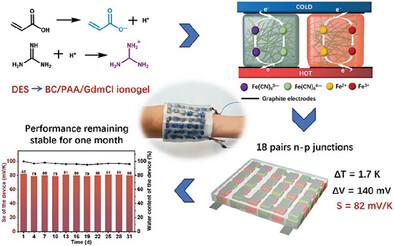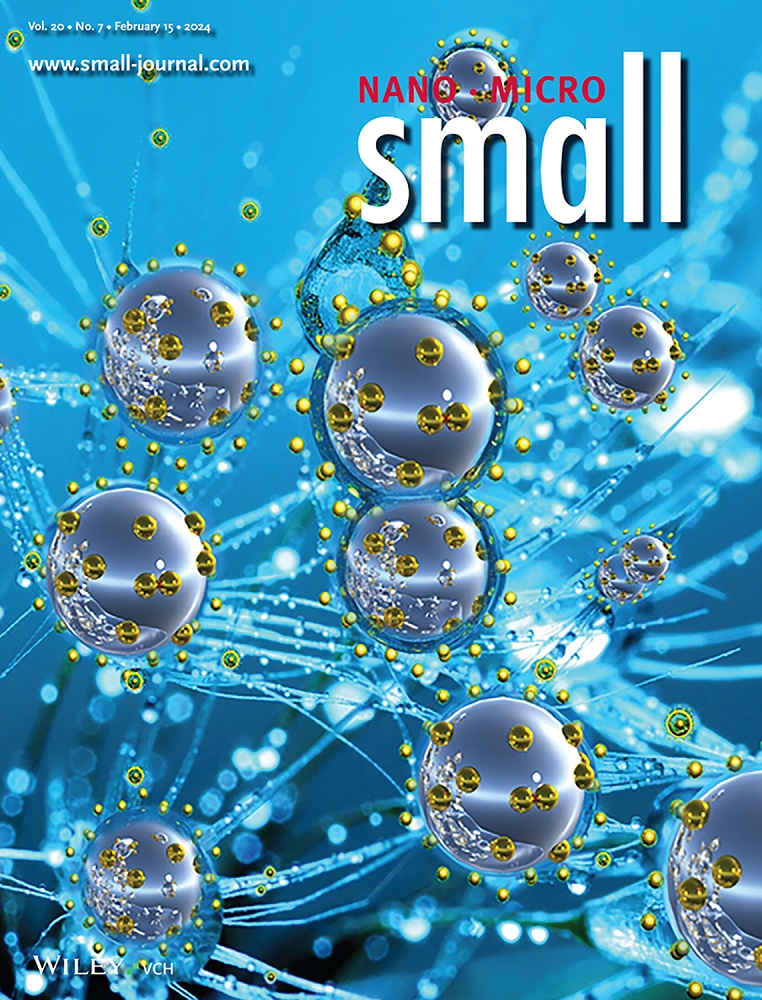Wearable Device with High Thermoelectric Performance and Long-Lasting Usability Based on Gel-Thermocells for Body Heat Harvesting
IF 13
2区 材料科学
Q1 CHEMISTRY, MULTIDISCIPLINARY
引用次数: 0
Abstract
Utilizing the thermogalvanic effect, flexible thermoelectric materials present a compelling avenue for converting heat into electricity, especially in the context of wearable electronics. However, prolonged usage is hampered by the limitation imposed on the thermoelectric device's operational time due to the evaporation of moisture. Deep eutectic solvents (DESs) offer a promising solution for low-moisture gel fabrication. In this study, a bacterial cellulose (BC)/polyacrylic acid (PAA)/guanidinium chloride (GdmCl) gel is synthesized by incorporating BC into the DES. High-performance n-type and p-type thermocells (TECs) are developed by introducing Fe(ClO4)2/3 and K3/4Fe(CN)6, respectively. BC enhances the mechanical properties through the construction of an interpenetrating network structure. The coordination of carboxyl groups on PAA with Fe3+ and the crystallization induced by Gdm+ with [Fe(CN)6]4− remarkably improve the thermoelectric performance, achieving a Seebeck coefficient (S) of 2.4 mV K−1 and ion conductivity (σ) of 1.4 S m−1 for the n-type TEC, and ‒2.8 mV K−1 and 1.9 S m−1 for the p-type TEC. A flexible wearable thermoelectric device is fabricated with a S of 82 mV K−1 and it maintains a stable output over one month. This research broadens the application scope of DESs in the thermoelectric field and offers promising strategies for long-lasting wearable energy solutions.

基于凝胶热电池的高热电性能和持久可用性的可穿戴设备,用于收集人体热量
利用热电效应,柔性热电材料为将热量转化为电能提供了一条引人注目的途径,尤其是在可穿戴电子设备中。然而,由于湿气的蒸发会限制热电设备的工作时间,因此无法长期使用。深共晶溶剂(DES)为低水分凝胶的制造提供了一种前景广阔的解决方案。在本研究中,通过将细菌纤维素(BC)/聚丙烯酸(PAA)/氯化胍(GdmCl)加入 DES,合成了一种细菌纤维素(BC)/聚丙烯酸(PAA)/氯化胍(GdmCl)凝胶。通过引入Fe(ClO4)2/3和K3/4Fe(CN)6,分别开发出了高性能n型和p型热电偶(TEC)。碱性催化剂通过构建相互渗透的网络结构增强了机械性能。PAA 上的羧基与 Fe3+ 的配位以及 Gdm+ 与 [Fe(CN)6]4- 的结晶作用显著提高了热电性能,n 型 TEC 的塞贝克系数(S)达到 2.4 mV K-1,离子电导率(σ)达到 1.4 S m-1,p 型 TEC 的塞贝克系数(S)和离子电导率(σ)分别为 -2.8 mV K-1 和 1.9 S m-1。制作出的柔性可穿戴热电设备的 S 值为 82 mV K-1,并能在一个月内保持稳定输出。这项研究拓宽了 DES 在热电领域的应用范围,并为长效可穿戴能源解决方案提供了前景广阔的策略。
本文章由计算机程序翻译,如有差异,请以英文原文为准。
求助全文
约1分钟内获得全文
求助全文
来源期刊

Small
工程技术-材料科学:综合
CiteScore
17.70
自引率
3.80%
发文量
1830
审稿时长
2.1 months
期刊介绍:
Small serves as an exceptional platform for both experimental and theoretical studies in fundamental and applied interdisciplinary research at the nano- and microscale. The journal offers a compelling mix of peer-reviewed Research Articles, Reviews, Perspectives, and Comments.
With a remarkable 2022 Journal Impact Factor of 13.3 (Journal Citation Reports from Clarivate Analytics, 2023), Small remains among the top multidisciplinary journals, covering a wide range of topics at the interface of materials science, chemistry, physics, engineering, medicine, and biology.
Small's readership includes biochemists, biologists, biomedical scientists, chemists, engineers, information technologists, materials scientists, physicists, and theoreticians alike.
文献相关原料
| 公司名称 | 产品信息 | 采购帮参考价格 |
|---|
 求助内容:
求助内容: 应助结果提醒方式:
应助结果提醒方式:


